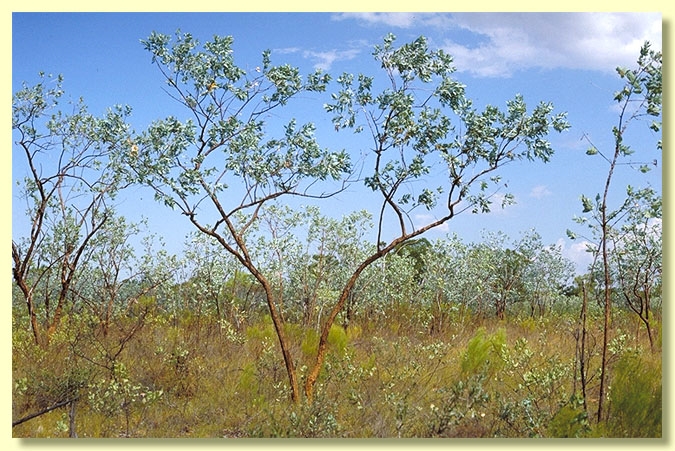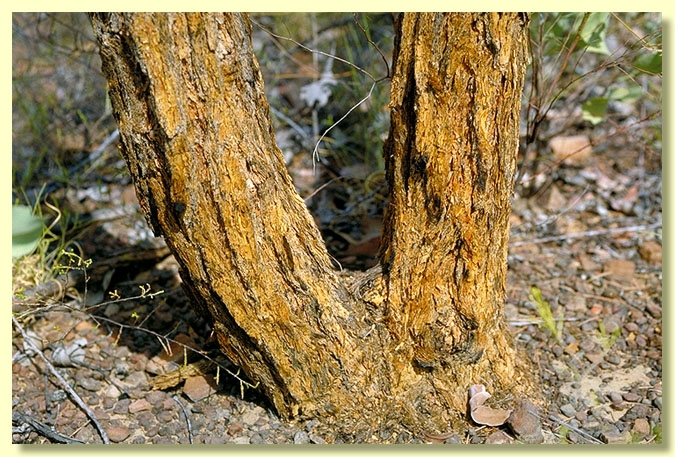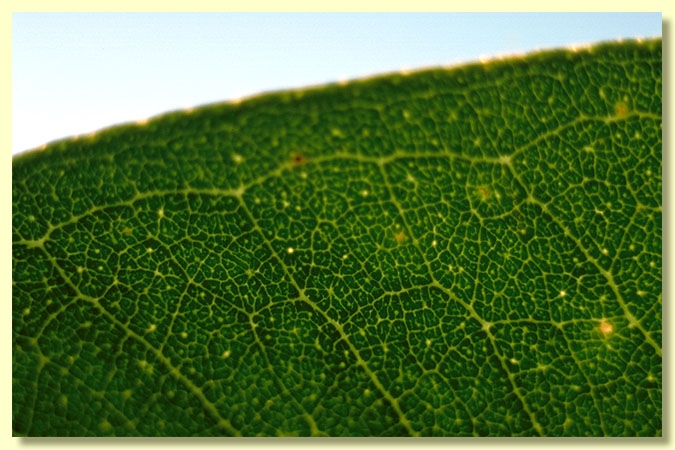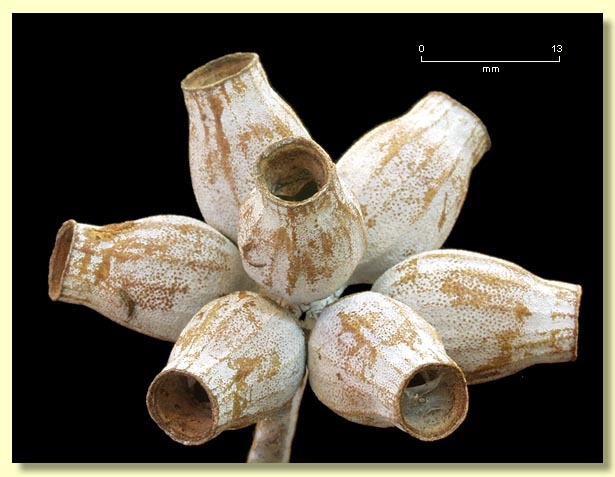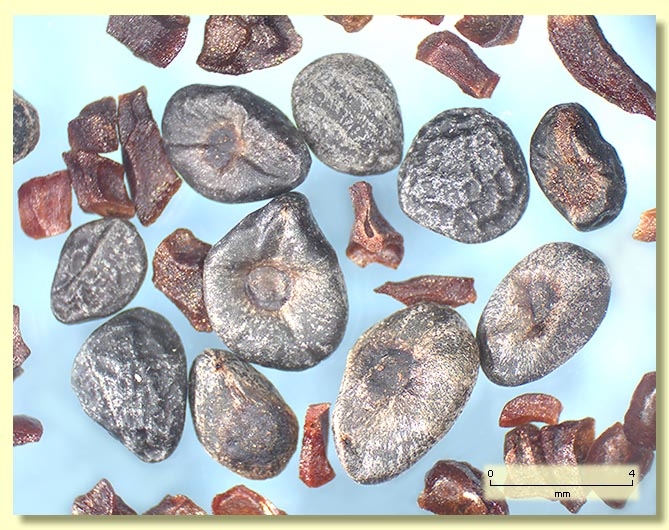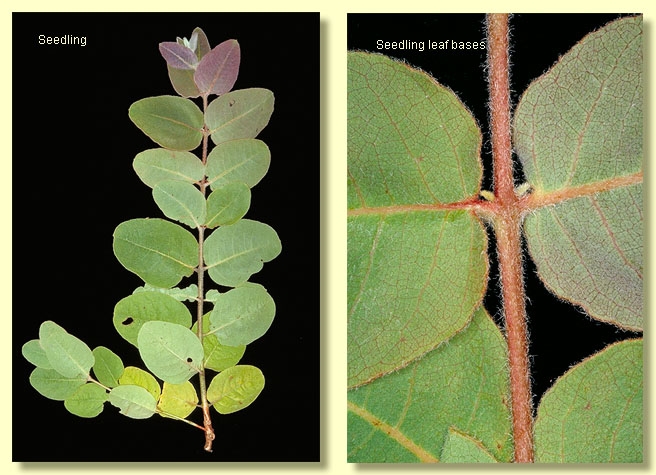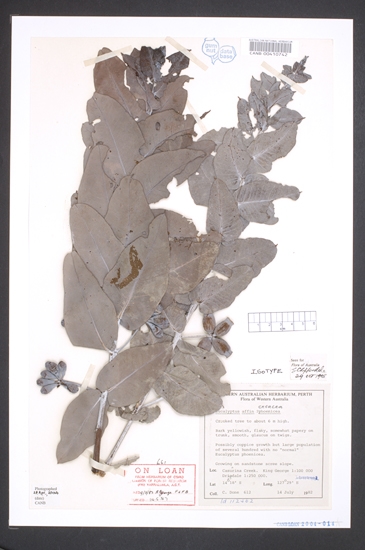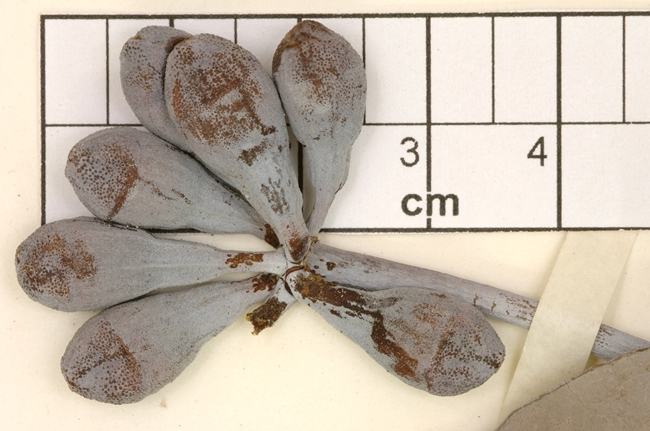Euclid - Online edition
Eucalyptus ceracea
Eucalyptus | Eudesmia | Reticulatae | Miniatae | Inclinatae
Small tree to 6 m tall, often multi-stemmed and mallee-like. Forming a lignotuber.
Soft thick, fibrous, or loosely flaky, papery rough bark over most the trunk and branches, rough bark yellow-brown to red-brown to orange-brown. Branchlets glaucous.
Juvenile growth (coppice or field seedlings to 50 cm): stems round in cross-section, hairy; juvenile leaves opposite, sessile, ovate, 6–10 cm long, 3–5.5 cm wide, base amplexicaul, apex acute, dull and glaucous, side-veins at a wider angle than 45° to the midrib, tertiary venation dense, intramarginal vein present, oil glands island or intersectional.
Mature crown consists entirely of juvenile leaves (described above).
Inflorescence axillary single, peduncles 1.2–4 cm long, rounded to flattened; buds 7–9 per umbel, pedicels to ca 0.5 cm long. Mature buds obovoid to pyriform, ca 1.5–1.7 cm long, ca 0.6 cm wide, glaucous, calyx fused to the corolla and evident as 4 small teeth at the apex of the bud, hypanthium weakly longitudinally striated or ribbed, operculum rounded to conical, stamens inflexed, anthers oblong, versatile, dorsifixed, dehiscing by longitudinal slits (non-confluent), style long, hooked or bent beneath the apex of the bud, stigma tapered, locules usually 3, the ovules usually arranged in 4 distinct vertical rows on the placentae. Flowers bright orange.
Fruit shortly pedicellate, pedicels 0.1–0.5 cm long, distinctly urceolate, weakly longitudinally ribbed, 1.7–3.3 cm long, 1.1–1.7 cm wide, glaucous, disc vertically descending, valves 3, enclosed.
Seeds dark grey to black, saucer-shaped to ± flattened ovoid, 3–4 mm long, dorsal surface smooth, rarely slightly lacunose, hilum ventral.
Cultivated seedlings (measured at node 10): not seen
Flowering has been recorded in June.
A small tree or mallee, known only from the tops and sides of sandstone escarpments in the Seppelt Range area of the northern Kimberley in Western Australia. It is characterised by its rough, papery or fibrous bark on the trunk and large branches, the entire mature crown of glaucous, opposite, juvenile leaves, the bright orange or scarlet filaments of the flower and the distinctly urceolate, glaucous fruit.
It belongs to the taxonomically complex Eucalyptus subgenus Eudesmia and is included in the section Reticulatae, series Miniatae, sub-series Inclinatae characterised by having the calyx fused to the corolla and evident as four small teeth at the apex of the bud, hairy seedlings, buds with a long style and bright orange flowers. Within the sub-series, it is morphologically closest to E. phoenicea, a relatively common species, occurring from the Kimberley in Western Australia, through the Top End of the Northern Territory, with an isolated occurrence north-west of Cooktown in North Queensland. E. ceracea can be distinguished by its mature crown of sessile, ovate, glaucous, juvenile leaves and the glaucous buds and fruit (mature crown leaves lanceolate, yellow-green to grey-green and buds and fruit not glaucous in E. phoenicea). The elongate-urceolate fruit distinguish E. ceracea from other species in series Miniatae (E. chartoboma, E. miniata and E. gigantangion.)
With its soft, fibrous, papery rough bark, its mature crown of juvenile, ovate, glaucous leaves, its many-budded umbels, the glaucous buds and fruit, the bright orange to scarlet flowers and the long urceolate fruit, E. ceracea should not be confused with any other eucalypt in the Kimberley region.
Eucalyptus ceracea is listed as "Vulnerable" under the Australian Government Environment Protection and Biodiversity Conservation Act 1999 (EPBC Act). Further information may be found at this web address:
http://www.environment.gov.au/cgi-bin/sprat/public/sprat.pl
Eucalyptus ceracea: Latin cereus, waxen, waxy, referring to the extreme waxiness of the whole plant.

